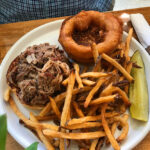Jason Sandford
Jason Sandford is a reporter, writer, blogger and photographer interested in all things Asheville.
Here’s a fascinating story about a true North Carolina beer pioneer. Note the end of the story, which explains how the Weeping Radish Farm Brewery is changing. It could provide a great model for the growth and expansion of micro-breweries here in Western North Carolina:
The Raleigh News & Observer has it:
Spend an hour talking with Uli Bennewitz and the conversation may start with beer, but it darts with lightning speed to health care, the German autobahn, the American manufacturing revolution, the integrity of our food supply, national security, the nightmares of bureaucracy and the education of chefs — then it’s back to beer.
Bennewitz is the single figure who completely changed the North Carolina beer scene when he got legislation passed in 1986 to make brewpubs legal. More than two decades later, he’s trying to reshape our view of food and drink again.
Bennewitz moved to North Carolina in the early ’80s to take a job as an agricultural consultant in Manteo. His brother back in Bavaria convinced him that a restaurant that brewed its own beer — a brewpub — would be a sure winner in America. The brewing equipment was en route to North Carolina before this newcomer discovered two obstacles: brewpubs were illegal in North Carolina, and Manteo was in a dry county.
Bennewitz managed to get legislation enacted, navigated the local dry laws and in 1986 opened his restaurant and brewery, the Weeping Radish, named for a snack that accompanies a good beer in Munich. It was the first microbrewery and brewpub in North Carolina: there are now about 30.
Now, the new Weeping Radish Farm Brewery, opened in Currituck in 2006, integrates all of Bennewitz’s diverse passions about beer, agriculture, food, health and community in one enterprise. The farm is a home for the traditional crafts of brewing, farming and butchery, all organized in an environmentally sustainable manner. The concept can be summed up as shortening what he terms the “food chain”– the steps, both in distance and in increasingly sophisticated processing, that food and drink undergo before they reach the consumer.
He explains his concerns: “In 2008, we have the most efficient food distribution system in the world. We also have the most polluted food chain in the world, because in order to do that, you have to take a perishable food and turn it into a nonperishable commodity.” That, in turn, takes a toll in human health and environmental quality.
Taking his example from beer, Bennewitz puts it this way:
“The best beer you ever see is perhaps at Oktoberfest in Munich. They make it, they age it for six months, they haul it across town and serve it in the beer tents the same day they tap it from the brewery. This is the issue of the food chain. If you can control the distribution, and the temperature and the pressure from the brewery to the tent all in the same day, you get quality.
“Small-scale farming is the same way. The farmers markets are superior in their products. Why? Because the farmer digs the vegetables the night before and hauls it to the farmers market.” With these parallels in mind, the Currituck site is home to a brewery and a 14-acre organic farm, so both of these perishable commodities are available fresh on site.
In an unusual step, Bennewitz has opened a butchery and smokehouse, in a joint venture with a German master butcher. Here, he points out similarities between the crafts of brewing and butchery, where specialized skills and labor are required to transform raw materials — grain or meat — into beer or properly prepared cured meats and sausages.
The brewery, the farm and the butchery all interact: The brewery’s Black Radish beer has been incorporated into meat dishes served in the farm restaurant; a liver pâté from the butchery contains organic sweet potato from the farm; and in the future, malts smoked in the smokehouse could be used to brew genuine German-style rauchbiers at the brewery.



















